RBSE Solutions for Class 10 Maths Chapter 5 Arithmetic Progression Miscellaneous Exercise is part of RBSE Solutions for Class 10 Maths. Here we have given Rajasthan Board RBSE Class 10 Maths Chapter 5 Arithmetic Progression Miscellaneous Exercise.
Rajasthan Board RBSE Class 10 Maths Chapter 5 Arithmetic Progression Miscellaneous Exercise
RBSE Class 10 Maths Chapter 5 Miscellaneous Question 1.
The common difference of two A.P.’s are same. (RBSESolutions.com) First term of one such in 8 and of other is 3. Then difference between their 30th terms :
(A) 11
(B) 3
(C) 8
(D) 8
Solution :
30th term of first A.P.
a30 = 8 + (30 – 1)d
= 8 + 29d
30th term of second A.P.
a’30 = 3 + (30 – 1)d
= 3 + 29d
a30 – a’30 = 5
Hence, option (D) is correct.
RBSE Solutions For Class 10 Maths Chapter 5 Miscellaneous Question 2.
If 18, a, b, -3 are in A.P. (RBSESolutions.com) then a + b =
(A) 19
(B) 7
(C) 11
(D) 15
Solution :
First term = 18
Second term 18 + d = a
Third term 18 + 2d = b
Fourth term 18 + 3d = -3
⇒ 3d = -3 – 18
⇒ 3d = -21
⇒ d = \(\frac { -21 }{ 3 }\) = -7
∴ Second term a = 18 + (-7) = 11
Third term b = 18 + 2 × (-7)
= 18 – 14 = 4
Thus, a + b = 11 + 4 = 15
Hence option (D) is correct
RBSE Solutions For Class 10 Maths Chapter 5 Question 3.
If 7th and 13th term of A.P. are 34 and 64 (RBSESolutions.com) respectively. Then its 18th term is :
(A) 89
(B) 88
(C) 87
(D) 90
Solution :
a7 = 34 (given)
a13 = 64 (given)
– 6d = -30
d = 5
put the value of d in a + 6d = 34
a + 6 × 5 = 34
a = 34 – 30
a = 4
∴ a18 = a + 17d
= 4 + 17 × 5 = 4 + 85 = 89
Thus, option (A) is correct.
Miscellaneous Exercise 5 Class 10 Question 4.
First and last term of A.P. are 2 and 34 respectively. (RBSESolutions.com) Sum of its terms is 90 then value of n will be :
(A) 3
(B) 4
(C) 5
(D) 6
Solution :
We have a = 2, l = 34, d = 8, Sn = 90
⇒ Sn = \(\frac { n }{ 2 }\) (a + l)
⇒ 90 = \(\frac { n }{ 2 }\) (a + l)
⇒ \(\frac { n }{ 2 }\) × 36 = 90
⇒ n × 18 = 90
⇒ n = \(\frac { 90 }{ 18 }\) = 5
⇒ n = 5
Hence, option (C) is correct.
RBSE Solutions For Class 10 Maths Chapter 5.1 Question 5.
If sum of n terms of A.P. is 3n2 + 5n, then its (RBSESolutions.com) which term is 164 :
(A) 12th
(B) 15th
(C) 27th
(D) 20th
Solution :
Given : Sn = 3n2 + 5n
S1 = 3(1)2 + 5(1) = 8
S2 = 3(2)2 + 5(2) = 22
S3 = 3(3)2 + 5(3) = 42
S4 = 3(4)2 + 5(4) = 68
∴ a1 = S1 = 8
a2 = S2 – S1 ⇒ 22 – 8 ⇒ 14
a3 = S2 – S1 ⇒ 22 – 8 ⇒ 14
a4 = S2 – S1 ⇒ 22 – 8 ⇒ 14
Thus A.P. will be 8, 14, 20, 26 …… 164
a = 8,
d = 14 – 8 = 6 and an = 164
∴ 164 = a + (n – 1)d
164 = 8 + (n – 1)
(n – 1) = 156/6 = 26
∴ n = 26 + 1 = 27
Hence, option (C) is correct.
Class 10 Maths RBSE Solution Chapter 5 Question 6.
If sum of n (RBSESolutions.com) terms of A.P. is Sn and S2n = 3Sn, then S3n : Sn will be :
(A) 10
(B) 11
(C) 6
(D) 4
Solution :
S2n = 3 Sn
\(\frac { 2n }{ 2 }\) [2a + (2n – 1)d] = \(\frac { 3n }{ 2 }\) [2a + (n – 1)d]
⇒ 4a + 4nd – 2d = 6a + 3nd – 3d
⇒ nd + d = 2a
Now, S3n : Sn
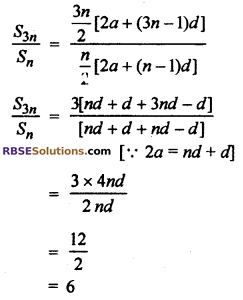
Hence, option (C) is correct.
RBSE Solution Class 10th Maths Question 7.
The first and last terms of an A.P. are 1 and 11 respectively. (RBSESolutions.com) If sum of its terms is 36 then number of terms will be :
(A) 5
(B) 6
(C) 9
(D) 11
Solution :
a= 1, l = 11, Sn = 36
Sn = \(\frac { n }{ 2 }\) (a + l)
36 = \(\frac { n }{ 2 }\) (1 + 11)
⇒ 36 = \(\frac { n }{ 2 }\) × 12
⇒ 36 = 6n
⇒ n = 6
Hence, option. (B) is correct.
RBSE Solutions For Class 10 Maths Chapter 5.1 Question 8.
Write 5th term of A.P. 3, 5, 7, 9, …., 201 from (RBSESolutions.com) last.
Solution :
Given A.P.
3, 5, 7, 9 …… 201
First term (a) = 3
Common difference (d) = 5 – 3 = 2
Last term (an) = 201
Formula : rth term from last = an – (r – 1)d
5th term from last = 201 – (5 – 1)2
= 201 – 4 × 2
= 201 – 8
= 193
Hence, 5th term from last 193.
RBSE Solutions For Class 10 Maths Question 9.
If three consecutive (RBSESolutions.com) terms of A.P. are \(\frac { 4 }{ 5 }\), a, 2, then find.
Solution :
Given A.P. \(\frac { 4 }{ 5 }\), a, 2
First term = \(\frac { 4 }{ 5 }\)
Second term a = \(\frac { 4 }{ 5 }\) + d
Third term 2 = \(\frac { 4 }{ 5 }\) + 2d
⇒ 2 – \(\frac { 4 }{ 5 }\) = 2d
⇒ \(\frac { 10-4 }{ 5 }\) = 2d
⇒ \(\frac { 6 }{ 5 }\) = 2d
⇒ 2d = \(\frac { 6 }{ 5 }\)
⇒ d = \(\frac { 3 }{ 5 }\)
Second term a = \(\frac { 4 }{ 5 }\) + d
= \(\frac { 4 }{ 5 }\) + \(\frac { 3 }{ 5 }\) = \(\frac { 7 }{ 5 }\)
Thus, a = \(\frac { 7 }{ 5 }\)
RBSE Solution.Com Class 10th Maths Question 10.
Find the sum of (RBSESolutions.com) first 1000 positive integers.
Solution :
Given A.P.
1, 2, 3, 4, 5 …….. 1000
First term (a) = 1
Common difference (d) = 2 – 1 = 1
Last term (l) = 1000
Formula, Sn = \(\frac { n }{ 2 }\) (a + l)
S1000 = \(\frac { 1000 }{ 2 }\) (1 + 1000)
= 500 × 1001 = 500500
Hence, sum of first 1000 positive integers.
= 500500
Www.RBSEsolutions.Com Class 10 Question 11.
Is any term of (RBSESolutions.com) sequence 5, 11, 17, 23, …. will be 299 ?
Solution :
Given A.P.
5, 11, 17, 23, ……..
First term (a) = 5
Common difference (d) = 11 – 5 = 6
nth term (an) = 299
Formula an = a + (n – 1)d
⇒ 299 = 5 + (n – 1) × 6
⇒ 299 – 5 = (n – 1) 6
⇒ 294 = (n – 1) 6
⇒ n – 1 = \(\frac { 294 }{ 6 }\)
⇒ n – 1 = 49
⇒ n = 49 + 1
⇒ n = 50
n is whole no.
∴ Hence, 299 is 50th term of sequence 5, 11, 17, 23 ….
RBSE Class 10 Maths Chapter 5 Question 12.
Which term (RBSESolutions.com) of AP. 20, 19 \(\frac { 1 }{ 4 }\), 18 \(\frac { 1 }{ 2 }\), 17 \(\frac { 3 }{ 4 }\),… is first negative term.
Solution :
Given series is A.P. whose
First term (a) = 20 and common difference
(d) = – 3/4
∴ Let the nth term of the given AP the first negative term then
an < 0
⇒ a + (n – 1)d < O
⇒ 20 + (n – 1) × – \(\frac { 3 }{ 4 }\) < 0
⇒ \(\frac { 83 }{ 4 }\) – \(\frac { 3n }{ 4 }\) < 0
⇒ 83 – 3n < 0 ⇒ 3n > 83
⇒ n > 27 \(\frac { 2 }{ 3 }\) ⇒ n ≥ 28
Thus, 29th term of the given sequence the first negative term.
Class 10 RBSE Solutions Maths Question 13.
Four numbers are in A.P. If their (RBSESolutions.com) sum is 20 and sum of their squares is 120, then find the numbers.
Solution :
Let in four numbers,
First number = a – 3d
Second number = a – d
Third number = a + d
Fourth number = a + 3d
Sum of four number is 20
∴ 20 = (a – 3d) + (a – d) + (a + d) + (a + 3d)
⇒ 20 = 4a
⇒ a = 5
Sum of squares of four (RBSESolutions.com) numbers is 120.
∴ (a – 3d)2 + (a – d)2 + (a + d)2 + (a + 3d)2 = 120
⇒ [a2 + 9d2 – 6ad + a2 + d2 – 2ad + a2 + d2 + 2ad + a2 + 9d2 + 6ad] = 120
⇒ 4 (a2 + 5d2) = 120
⇒ a2 + 5d2 = 30 [∵ a = 5]
⇒ 52 + 5d2 = 30
⇒ 25 + 5d2 = 30
⇒ 5d2 = 30 – 25
⇒ 5d2 = 5
⇒ d2 = 1
⇒ d = ±1
Thus, a = 5 and d = ± 1
∴ Four numbers are 2, 4, 6, 8 or 8, 6, 4, 2
RBSE Solutions For Class 10 Maths Chapter 12 Miscellaneous Question 14.
If sum of n terms (RBSESolutions.com) of A.P. is \(\frac { { 3n }^{ 2 } }{ 2 } +\frac { 5n }{ 2 }\) then find its 25th term.
Solution :
Given that, sum of n terms of A.P.
Sn = \(\frac { { 3n }^{ 2 } }{ 2 } +\frac { 5n }{ 2 }\)
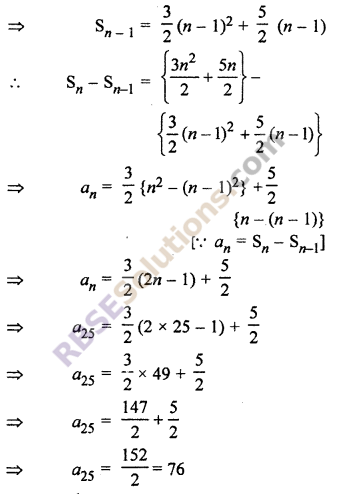
Hence 25th term will be 76.
RBSE Solution Class 10th Math Question 15.
The houses of a row are numbered (RBSESolutions.com) consecutively from 1 to 49. Show that there is value of x such that the sum of the numbers of the houses preceding the house numbered x is equal to the sum of the houses following it. Find the value of x.
Solution :
Consecutively marked number of houses are 1, 2, 3, 4 …… 47, 48, 49.
x is such number so that sum of one side of x numbers = sum of other side number of x d in all the terms of series = 1.
then sum of number from 1 to x – 1, (a) = 12, n = x – 1.
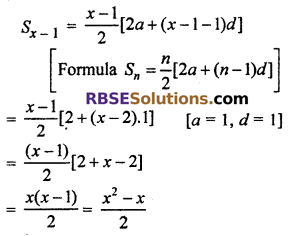
and sum of numbers from x + 1 to 49
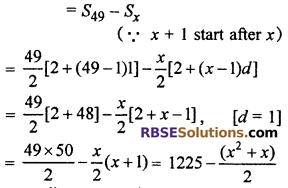
Then according (RBSESolutions.com) to question,
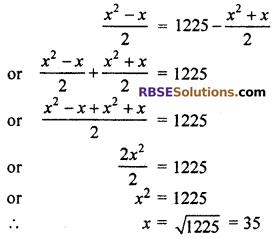
Hence, value of x is 35.
We hope the given RBSE Solutions for Class 10 Maths Chapter 5 Arithmetic Progression Miscellaneous Exercise will help you. If you have any query regarding Rajasthan Board RBSE Class 10 Maths Chapter 5 Arithmetic Progression Miscellaneous Exercise, drop a comment below and we will get back to you at the earliest.